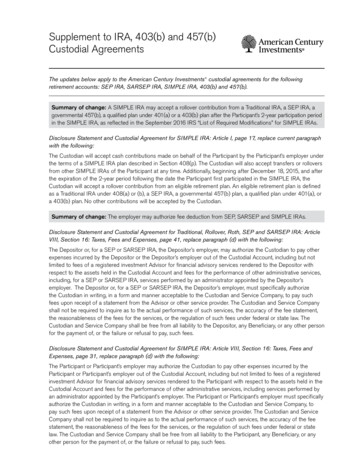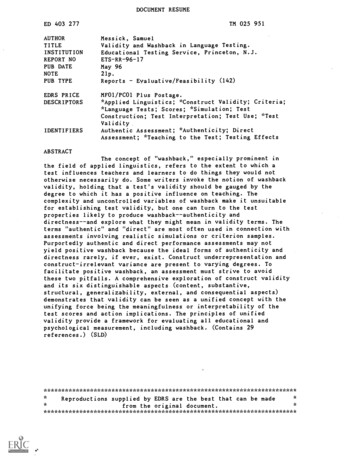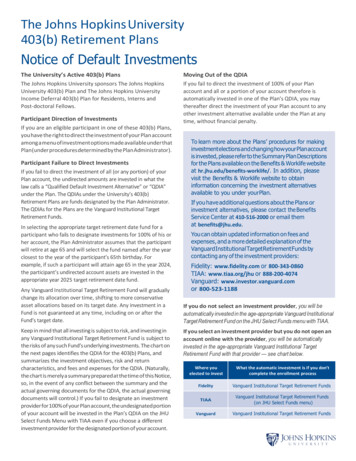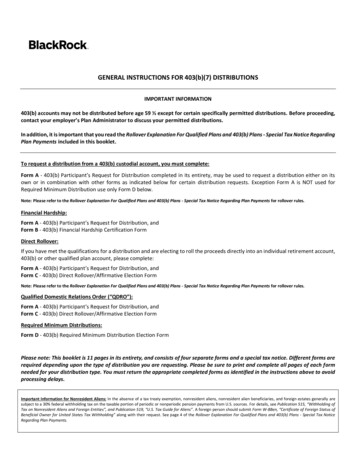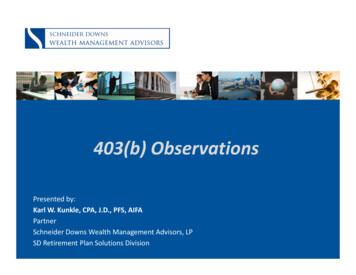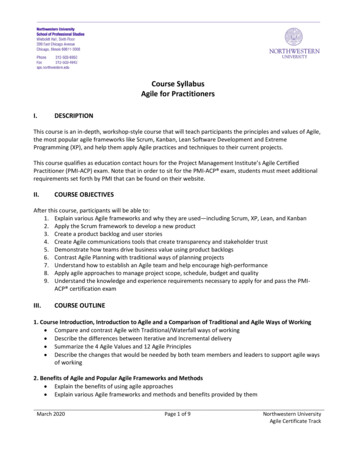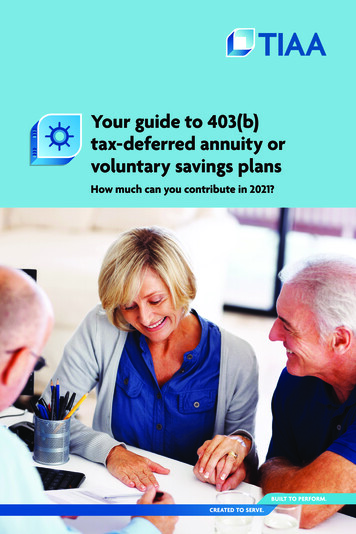
Transcription
Your guide to 403(b)tax-deferred annuity orvoluntary savings plansHow much can you contribute in 2021?
Tax-deferred annuity plans are voluntary savings plans designed to help you buildsavings for your retirement.In this brochure, we’ll explain the contribution limits set by the Internal RevenueCode (IRC). Plus, we’ll show you how to calculate your maximum contributionamount so you can be sure to take full advantage of your opportunity to save.About TIAATIAA’s purpose has remained constant for more than 100 years: To help you savefor—and generate income during—retirement. For more information, visit us atTIAA.org or call us at 800-842-2252.
What is a tax-deferred annuity plan?A tax-deferred annuity (TDA) plan is a type of retirement plandesigned to complement your employer’s base retirement plan.Sometimes, a TDA plan is also referred to as a voluntary savingsplan, a supplemental plan, a tax-sheltered annuity (TSA) or simplya 403(b) plan.A TDA plan is an employer-sponsored Defined Contributionretirement plan to which you can contribute a percentage ofyour base salary.Retirement plan contribution limitsThere are maximum limits to how much you can contribute to your retirementplans each year. These are governed by Sections 415 and 402(g) of the InternalRevenue Code (IRC).WW For your employer’s 403(b) plan. The Defined Contribution limit applies toall pretax and after-tax (i.e., non-Roth and Roth) contributions; mandatoryemployee contributions; and all employer-matching and nonmatchingcontributions. In 2021, the limit is the lesser of 58,000 or 100%of compensation.WW Salary reduction. The elective deferral limit applies to pretax and after-tax(designated Roth) contributions that you voluntarily make under a salaryreduction agreement with your employer. The combined pretax and after-taxelective deferral contributions to all 403(b) and 401(k) plans (even with differentemployers) and Simple IRA plans cannot exceed this limit.Your guide to 403(b) tax-deferred annuity or voluntary savings plans3
Your contributionsContributions to a TDA plan are usually made before taxes. This means yourcontributions reduce your current taxable income and the taxes you currentlyowe. In addition to the contributions being tax deferred, any earnings on your TDAplan are also tax deferred. This means that your savings have the potential togrow faster because your contributions and investment earnings aren’t taxed untilyou withdraw them as income, usually at retirement.1 Pretax contributions may bea good choice if you think your tax rates will decrease after you retire.If your employer’s plan permits, you may also make contributions after taxesare taken out, known as “Roth contributions.”2 Generally, these after-tax Rothcontributions and their earnings can be withdrawn tax free, as long as you’re atleast age 59½ and your Roth account is at least five years old. After-tax Rothcontributions may be a good choice if you think your tax rates will stay the sameor increase after you retire.How much can you contribute?For 2021, the most you can contribute to your TDA is 19,500.3 However,depending on your age and your years of service, your maximum may be higher.If you are age 50 or older in 2021 and your employer’s plan permits it, youcan also set aside an extra amount called the “age 50 catch-up.” The age50 catch-up limit for 2021 is 6,500. Keep in mind that if you participate inboth a 403(b) and a 401(k) plan, the contribution limit and age 50 catch-upcontributions for both plans are combined.If you have 15 or more years of service and participate in a 403(b) plan throughan eligible employer,4 you may be able to contribute an additional 3,000 abovethe basic contribution limit, if your employer’s plan permits. It’s important tokeep in mind:WW This 15-year catch-up is only available if you have contributed, on average,less than 5,000 a year to your 403(b) plan; andWW There is a lifetime limit of 15,000, with each additional contribution youmake applied toward that limit. For example, if you contributed 3,000 overthe plan contribution limit for five years and you reached the 15,000 lifetimelimit, you would not be able to make additional contributions under the15-year catch-up.4Your guide to 403(b) tax-deferred annuity or voluntary savings plans
WW When considering years of service, you should adjust your total to take intoaccount any part-time work or breaks in service. For example, if you worked50% of the time for the past two years, your years of service would beconsidered one year.2021 contribution limits at a glanceIf you are:AgeYears of serviceYour contribution limit is:Under 50Less than 15 19,500Under 50More than 15 22,50050 or olderLess than 15 26,00050 or olderMore than 15 29,000Note: Contributions above the basic 19,500 limit count against your 15-year catch-up lifetimelimit first. Only amounts above both the basic 19,500 and 15-year catch-up count as age 50 catch-up contributions.Calculating your maximum contribution amountIn the following pages we provide three tables and other information to help youunderstand how much you can contribute:WW Table A—Information you need for your calculationWW Adjustments to your calculation informationWW Table B—15-year catch-up calculationWW Table C—Your maximum contribution limit calculationYour guide to 403(b) tax-deferred annuity or voluntary savings plans5
Table A—Information you need for your calculationThe table below shows the information you’ll need to calculate your contributionlimit. The table provides a sample calculation for a hypothetical staff member,Professor Green. We assume that Professor Green has been employed for15 years at an eligible institution and is under 50 years old.YourcalculationProf. Green’scalculationSalary5This includes:WW Salary for the year in which the calculation is being performed6WW Any taxable cafeteria/flexible benefit credits or contributionsto flexible spending, healthcare accounts or Section 132transportation fringe benefitsLINE 1 70,000ContributionsA. Employer contributions5A. 4,200B. 0Contributions your employer will make for you in 2021 under itsDefined Contribution planB. After-tax contributions5Contributions you will make in 2021 from income that has alreadybeen taxed (these are not after-tax designated Roth contributions)LINE 2—TOTAL Contributions (A B) 4,200Years of serviceThis includes:WW Years of service with your employer through the end of 2021WW Fractional years of service, adjusted to account for any part-timeemployment (e.g., 50% of full-time service equals .5 years) orany breaks in service, such as leaves of absence without pay,which cannot be countedLINE 36Your guide to 403(b) tax-deferred annuity or voluntary savings plans15
Table A (Cont’d)YourcalculationProf. Green’scalculationIf Line 3 is less than 15 years, go to the section below to see if you need to adjust the salary orcontribution information above. Then you are ready to calculate your maximum limit in Table C.If Line 3 is 15 or more years, answer the following questions to see if you are eligible for 15-yearcatch-up contributions:WW Do you currently work for an eligible institution (e.g., a teaching institution, hospital, church, homehealthcare service organization, health and welfare service agency)?YesNoqqWW Do you have 15 or more years of full-time service at that institution? Your years of service mustaccount for fractional years of service.YesNoqqIf you answered “Yes” to both questions, you may be eligible for the 15-year catch-up. Please enterthe information requested in Line 4 and complete the 15-year catch-up calculation on page 8. Thenreview the section below on adjustments before moving on to Table C. If you answered “No” to eitherquestion, review the section below and see if you need to adjust the salary or contribution informationabove. Then you are ready to calculate your maximum limit in Table C.Your prior elective deferralsCumulative amount of all pretax and Roth elective deferrals for prioryears at current employer (elective deferrals only; do not includecontributions to a plan that requires employee contributions thatare mandatory as a condition of employment)LINE 4 45,000Adjustments to your calculation informationDepending on your situation, you may need to adjust some of the informationyou enter in Table A on page 6, which could affect your calculation results. Thisapplies to:WW Mandatory employee 403(b) contribution—Adjust your calculation informationby subtracting your required contribution from your salary and then adding itto your employer’s plan contributions. These are employee contributions thatare required as a condition of employment as authorized by the Technical andMiscellaneous Revenue Act (TAMRA).Your guide to 403(b) tax-deferred annuity or voluntary savings plans7
WW Employer pick-up amounts paid to a Defined Contribution or Defined Benefitplan—Adjust your calculation information by subtracting your requiredcontribution from your salary. These employee contributions are treated as ifthey were employer contributions because they are required as a condition ofemployment or made under one-time irrevocable salary reduction agreements.Any pretax contributions to purchase service credits in a Defined Benefit planshould also be subtracted from your salary.Not sure? We can help.If you’re a TIAA participant and are not sure what type of retirement planyou are in or the type of contributions you are making to that plan, pleasecall us at 800-842-2252.If you do not participate in a TIAA-sponsored plan and need to determinewhat type of retirement plan you are in or type of contributions you aremaking to that plan, contact your payroll department or plan administrator.Table B—15-year catch-up calculationIf you answered “Yes” to both questions on page 7, you are eligible for the 15-yearcatch-up. Please complete the calculation below to determine your catch-up amount.YourcalculationI. 3,000 (standard catch-up amount)II. 15,000 less any contributions you’ve made above the basic402(g) limit in previous years. The limit is 19,500 in 2021.(For Professor Green this is 15,000 less 0 since this is hisfirst time contributing under the 15-year catch-up.) 3,000 III. 5,000 multiplied by years of service that you entered in Line3, Table A. (For Professor Green it will be 15 since he has15 years of service in 2021.) From this subtotal, subtract the elective deferral contributionsfrom Line 4, Table A. (This is 45,000 for Professor Green.)– 15,000– 0 15,000 5,000 5,000 15 75,000– 45,000 IV. Take the 402(g) limit and add the lowest of I, II and III above.(For Professor Green it is 3,000 since it’s his first year.) Use this amount in Calculation 3, Table C on page 9. 8 3,000 15,000–TOTALTOTALProf. Green’scalculation 30,000 19,500Your guide to 403(b) tax-deferred annuity or voluntary savings plans 19,500 3,000 22,500
Table C—Your maximum contribution limit calculationAs mentioned on page 3, limits on employer and employee pre- and post-taxcontributions are found in Sections 415 and 402(g) of the IRC. In 2021, the 415limit is the lesser of 58,000 or 100% of compensation, and the 402(g) generallimit on all elective deferrals is 19,500. Using the information you entered inTable A, complete the calculations below. Your maximum contribution will be thelowest result of the three calculations.YourcalculationProf. Green’scalculationCalculation 1.Enter 100% of your salary. Refer to Line 1, Table A. Enter the total contributions from Line 2, Table A (for Professor Green thisis 4,200). Then subtract this amount from the line above.–Enter result for Calculation 1 here. 70,000– 4,200 65,800Calculation 2.Enter the 415 limit: 58,000 58,000 58,000Enter the total contributions from Line 2, Table A (same amount you enteredin the second line above), and subtract this amount from the 415 limit.–– 4,200Enter result for Calculation 2 here. 53,800 22,500Calculation 3.If you have less than 15 years of service and in 2021 you are:WW Under age 50, enter 19,500WW Age 50 or over, enter 26,000 ( 19,500 6,500)7If you have 15 or more years of service and in 2021 you are:WW Under age 50, enter the amount from item IV, page 8WW Age 50 or over, enter the amount from item IV, page 8 6,5007For Professor Green it’s 22,500 ( 19,500 3,000) because heis under age 50 and eligible for the 3,000 catch-up under the15-year rule.Enter result for Calculation 3 here.Your maximum contribution limit is the lowest of the amounts you entered inCalculations 1, 2 and 3.As shown above, the 2021 maximum contribution limit for Professor Greenis 22,500.Your guide to 403(b) tax-deferred annuity or voluntary savings plans9
Why your maximum limitmay changeSince the results of your maximum contribution calculations depend on severalfactors that may change from year-to-year, your maximum limit may also change.Here are some things to keep in mind.Your TDA limit may increase if: Your TDA limit may decrease if:WW You are receiving additionalcompensation, e.g.,through bonuses and yourcompensation goes over the415 limitWW You have at least 15 years offull-time service with an eligibleemployer and are eligible tomake catch-up contributionsWW You have reached age 50and are now eligible forcatch-up contributionsWW You are contributing to a 403(b) or 401(k)plan with another employer (you mustaggregate all elective deferrals to allplans for the 402(g) limit)WW Your includible compensation goeslower than the 415 limit, currently setat 58,000.WW You have reached the 15,000maximum allowed under the15-year catch-upWW Your average annual elective deferralsreach 5,000 or more and you have atleast 15 years of full-time serviceRemember: With tax deferral, it costs you less to contribute more.And it’s never too late to start or increase your contributions.If you’re contributing the maximum to your workplace retirement plans, you’vemade a great start. But what if you want to save more for retirement?WW Consider a Traditional or Roth IRA, if eligible. If you’re self-employed, you cantake advantage of a Simplified Employee Pension (SEP) IRA or Keogh plan.WW You can also invest after-tax money in mutual funds, a regular brokerageaccount or after-tax annuities.10Your guide to 403(b) tax-deferred annuity or voluntary savings plans
Next stepsMost people have no trouble staying within the allowable limits. But keep in mindthat you may face adverse tax consequences if you contribute above your limit ina given year.To avoid contributing too much, be sure to get a calculation every year so you cankeep track of your contributions. You can get one online at TIAA.org/tdacalcs.If you would like to speak with a consultant, you can also call us at 800-842-2252,weekdays, 8 a.m. to 10 p.m. (ET). You can also set up a meeting at one of ouroffices nationwide by visiting TIAA.org/local.When you meet with us, be sure to have:WW Your salary during 2021. You may want to consult your benefits office toensure you provide us with the appropriate salary.WW The date you were hired at your current employer or the years of service, ifyou’re employed at an eligible institution. This will help determine if you’reeligible for 15-year catch-up contributions.WW Your date of birth to determine if you qualify for the age 50 catch-up contributionsWW Any contributions you are making or have made to plans or accounts withother recordkeepers and employersWW A recent pay stub may be helpful for referenceYour guide to 403(b) tax-deferred annuity or voluntary savings plans11
Withdrawals are subject to ordinary income tax. An additional 10% penalty tax may apply towithdrawals made prior to age 59½.2Some plans may also permit non-Roth after-tax contributions.3Your employer’s plan may have a 200 minimum contribution per year.4Eligible employers are teaching institutions, hospitals, certain churches, home healthcare serviceorganizations, and health and welfare agencies.5Please see page 7 to determine if you need to adjust your salary or the contribution amounts.Non-Roth after-tax contributions are included for the 415 limit, but not the 402(g) limit.6If you are using a projected salary, keep in mind that your actual contribution limits may vary fromcalculation results based on your actual salary and contributions.7The age 50 catch-up is separate from the 415 limit; the 15-year catch-up is included in the415 limit.This material is for informational or educational purposes only and does not constitute fiduciaryinvestment advice under ERISA, a securities recommendation under all securities laws, or aninsurance product recommendation under state insurance laws or regulations. This material doesnot take into account any specific objectives or circumstances of any particular investor, or suggestany specific course of action. Investment decisions should be made based on the investor’s ownobjectives and circumstances.1This brochure provides general tax information to assist you in planning your contributions and is notintended as tax advice. Taxpayers should seek advice based on their own particular circumstancesfrom an independent tax advisor.For participants in the Texas ORP only: Under Texas law, the benefits of an annuity purchased underthe Optional Retirement Program are available only if a participant attains the age of 70½ years orterminates participation in the program. For these purposes, a person terminates participation inthe Optional Retirement Program, without losing any accrued benefits, by: (1) death; (2) retirement;or (3) termination of employment in all Texas public institutions of higher education.Annuity contracts contain exclusions, limitations, reductions of benefits, andmay contain terms for keeping them in force. We can provide you with costs andcomplete details.Investment, insurance, and annuity products are not FDIC insured, are not bankguaranteed, are not bank deposits, are not insured by any federal governmentagency, are not a condition to any banking service or activity, and may lose value.Investments products may be subject to market and other risk factors. See the applicable productliterature, or visit TIAA.org for details.You should consider the investment objectives, risks, charges, and expensescarefully before investing. Please call 877-518-9161 or go to TIAA.org/prospectusesfor current product and fund prospectuses that contain this and other information.Please read the prospectuses carefully before investing.TIAA-CREF Individual & Institutional Services, LLC, Member FINRA, distributes securities products.Retirement plan annuity contracts and certificates are issued by Teachers Insurance and AnnuityAssociation of America (TIAA) and College Retirement Equities Fund (CREF), New York, NY. After-taxannuities are issued by TIAA-CREF Life Insurance Co., New York, NY. Each of the foregoing is solelyresponsible for its own financial condition and contractual obligations. 2020 Teachers Insurance and Annuity Association of America-College Retirement Equities Fund,730 Third Avenue, New York, NY 1001713999481410381821475800 1657862A10642 (11/20)
A tax-deferred annuity (TDA) plan is a type of retirement plan designed to complement your employer’s base retirement plan. Sometimes, a TDA plan is also referred to as a voluntary savings plan, a supplemental plan, a tax-sheltere


